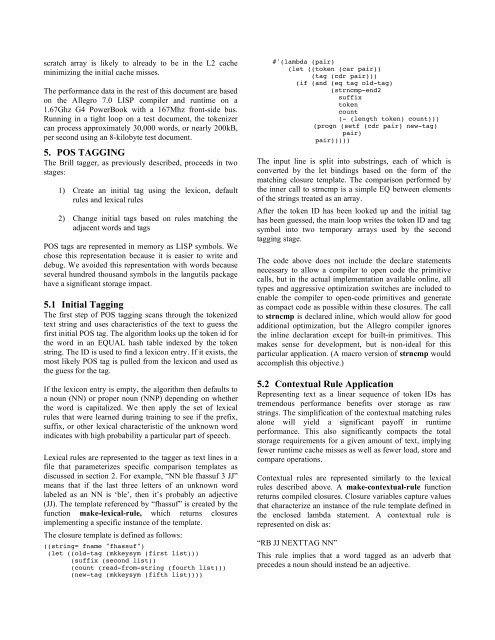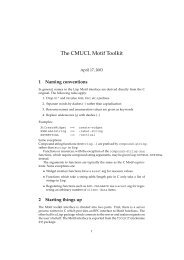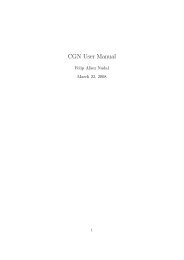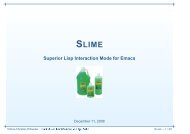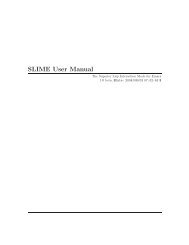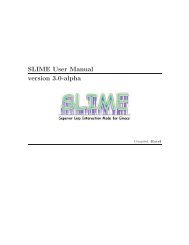Langutils: A Natural Language Toolkit for Common Lisp - Liu, Hugo
Langutils: A Natural Language Toolkit for Common Lisp - Liu, Hugo
Langutils: A Natural Language Toolkit for Common Lisp - Liu, Hugo
Create successful ePaper yourself
Turn your PDF publications into a flip-book with our unique Google optimized e-Paper software.
scratch array is likely to already to be in the L2 cache<br />
minimizing the initial cache misses.<br />
The per<strong>for</strong>mance data in the rest of this document are based<br />
on the Allegro 7.0 LISP compiler and runtime on a<br />
1.67Ghz G4 PowerBook with a 167Mhz front-side bus.<br />
Running in a tight loop on a test document, the tokenizer<br />
can process approximately 30,000 words, or nearly 200kB,<br />
per second using an 8-kilobyte test document.<br />
5. POS TAGGING<br />
The Brill tagger, as previously described, proceeds in two<br />
stages:<br />
1) Create an initial tag using the lexicon, default<br />
rules and lexical rules<br />
2) Change initial tags based on rules matching the<br />
adjacent words and tags<br />
POS tags are represented in memory as LISP symbols. We<br />
chose this representation because it is easier to write and<br />
debug. We avoided this representation with words because<br />
several hundred thousand symbols in the langutils package<br />
have a significant storage impact.<br />
5.1 Initial Tagging<br />
The first step of POS tagging scans through the tokenized<br />
text string and uses characteristics of the text to guess the<br />
first initial POS tag. The algorithm looks up the token id <strong>for</strong><br />
the word in an EQUAL hash table indexed by the token<br />
string. The ID is used to find a lexicon entry. If it exists, the<br />
most likely POS tag is pulled from the lexicon and used as<br />
the guess <strong>for</strong> the tag.<br />
If the lexicon entry is empty, the algorithm then defaults to<br />
a noun (NN) or proper noun (NNP) depending on whether<br />
the word is capitalized. We then apply the set of lexical<br />
rules that were learned during training to see if the prefix,<br />
suffix, or other lexical characteristic of the unknown word<br />
indicates with high probability a particular part of speech.<br />
Lexical rules are represented to the tagger as text lines in a<br />
file that parameterizes specific comparison templates as<br />
discussed in section 2. For example, “NN ble fhassuf 3 JJ”<br />
means that if the last three letters of an unknown word<br />
labeled as an NN is ‘ble’, then it’s probably an adjective<br />
(JJ). The template referenced by “fhassuf” is created by the<br />
function make-lexical-rule, which returns closures<br />
implementing a specific instance of the template.<br />
The closure template is defined as follows:<br />
((string= fname "fhassuf")<br />
(let ((old-tag (mkkeysym (first list)))<br />
(suffix (second list))<br />
(count (read-from-string (fourth list)))<br />
(new-tag (mkkeysym (fifth list))))<br />
#'(lambda (pair)<br />
(let ((token (car pair))<br />
(tag (cdr pair)))<br />
(if (and (eq tag old-tag)<br />
(strncmp-end2<br />
suffix<br />
token<br />
count<br />
(- (length token) count)))<br />
(progn (setf (cdr pair) new-tag)<br />
pair)<br />
pair)))))<br />
The input line is split into substrings, each of which is<br />
converted by the let bindings based on the <strong>for</strong>m of the<br />
matching closure template. The comparison per<strong>for</strong>med by<br />
the inner call to strncmp is a simple EQ between elements<br />
of the strings treated as an array.<br />
After the token ID has been looked up and the initial tag<br />
has been guessed, the main loop writes the token ID and tag<br />
symbol into two temporary arrays used by the second<br />
tagging stage.<br />
The code above does not include the declare statements<br />
necessary to allow a compiler to open code the primitive<br />
calls, but in the actual implementation available online, all<br />
types and aggressive optimization switches are included to<br />
enable the compiler to open-code primitives and generate<br />
as compact code as possible within these closures. The call<br />
to strncmp is declared inline, which would allow <strong>for</strong> good<br />
additional optimization, but the Allegro compiler ignores<br />
the inline declaration except <strong>for</strong> built-in primitives. This<br />
makes sense <strong>for</strong> development, but is non-ideal <strong>for</strong> this<br />
particular application. (A macro version of strncmp would<br />
accomplish this objective.)<br />
5.2 Contextual Rule Application<br />
Representing text as a linear sequence of token IDs has<br />
tremendous per<strong>for</strong>mance benefits over storage as raw<br />
strings. The simplification of the contextual matching rules<br />
alone will yield a significant payoff in runtime<br />
per<strong>for</strong>mance. This also significantly compacts the total<br />
storage requirements <strong>for</strong> a given amount of text, implying<br />
fewer runtime cache misses as well as fewer load, store and<br />
compare operations.<br />
Contextual rules are represented similarly to the lexical<br />
rules described above. A make-contextual-rule function<br />
returns compiled closures. Closure variables capture values<br />
that characterize an instance of the rule template defined in<br />
the enclosed lambda statement. A contextual rule is<br />
represented on disk as:<br />
“RB JJ NEXTTAG NN”<br />
This rule implies that a word tagged as an adverb that<br />
precedes a noun should instead be an adjective.


